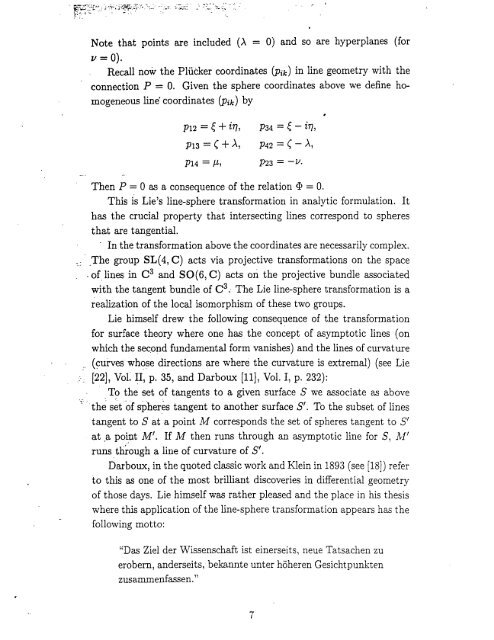Sophus Lie, the mathematician
Sophus Lie, the mathematician
Sophus Lie, the mathematician
Create successful ePaper yourself
Turn your PDF publications into a flip-book with our unique Google optimized e-Paper software.
Note that points are included (A = 0) and so are hyperplanes (forv = 0).Recall now <strong>the</strong> Pliicker coordinates (Pik) in line geometry with <strong>the</strong>connection P = 0. Given <strong>the</strong> sphere coordinates above we define homogeneousline' coordinates (Pik) byp2 = + i77, p 3 4 = - i77,P13 = A, P 42 = - A,P14 = 1, P23 = -V.'Then P = 0 as a consequence of <strong>the</strong> relation 4( = 0.This is <strong>Lie</strong>'s line-sphere transformation in analytic formulation. Ithas <strong>the</strong> crucial property that intersecting lines correspond to spheresthat are tangential.In <strong>the</strong> transformation above <strong>the</strong> coordinates are necessarily complex.The group SL(4, C) acts via projective transformations on <strong>the</strong> spaceof lines in C 3 and SO(6, C) acts on <strong>the</strong> projective bundle associatedwith <strong>the</strong> tangent bundle of C 3 . . The <strong>Lie</strong> line-sphere transformation is arealization of <strong>the</strong> local isomorphism of <strong>the</strong>se two groups.<strong>Lie</strong> himself drew <strong>the</strong> following consequence of <strong>the</strong> transformationfor surface <strong>the</strong>ory where one has <strong>the</strong> concept of asymptotic lines (onwhich <strong>the</strong> second fundamental form vanishes) and <strong>the</strong> lines of curvature(curves whose directions are where <strong>the</strong> curvature is extremal) (see <strong>Lie</strong>[22], Vol. II, p. 35, and Darboux [11], Vol. I, p. 232):To <strong>the</strong> set of tangents to a given surface S we associate as above<strong>the</strong> set of spheres tangent to ano<strong>the</strong>r surface S'. To <strong>the</strong> subset of linestangent to S at a point M corresponds <strong>the</strong> set of spheres tangent to S'at a point M'. If M <strong>the</strong>n runs through an asymptotic line for S, M'runs through a line of curvature of S'.Darboux, in <strong>the</strong> quoted classic work and Klein in 1893 (see [18]) referto this as one of <strong>the</strong> most brilliant discoveries in differential geometryof those days. <strong>Lie</strong> himself was ra<strong>the</strong>r pleased and <strong>the</strong> place in his <strong>the</strong>siswhere this application of <strong>the</strong> line-sphere transformation appears has <strong>the</strong>following motto:"Das Ziel der Wissenschaft ist einerseits, neue Tatsachen zuerobern, anderseits, bekannte unter h6heren Gesichtpunktenzusammenfassen."7
















